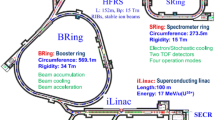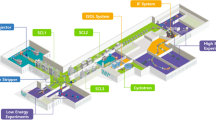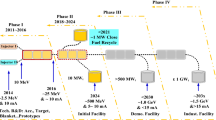Abstract
Shenzhen Superconducting Soft-X-ray Free Electron Laser (S3FEL) is located at Shenzhen, China. It is planned to construct a 2.5 GeV CW superconducting radio frequency linear accelerator and four beam lines, aiming at generating X-rays with a high repetition frequency. The accelerator consists of twenty-five 1.3 GHz cryomodules (CM) and two 3.9 GHz cryomodules, of which its SRF cavity need to be operated at 2 K condition. To maintain the 2 K environment, cryogenic distribution system (CDS) is designed to interconnect the CMs and the Cryoplant (CP) and supply cryogens from the CP to the LINAC. This paper presents the preliminary design result and current status of the CDS, which including overall specification and design consideration. In addition, a thermodynamic calculation is performed based on current design result. Those analyses provide sufficient evidence for the performance margin of the CDS design.
Access provided by Autonomous University of Puebla. Download conference paper PDF
Similar content being viewed by others
Keywords
- S3FEL
- Superconducting Linear Accelerator
- Cryogenic Distribution System
- Pressure Drop
- Flow Process Analysis
1 Introduction
The Shenzhen Superconducting Soft-X-ray Free Electron Laser (S3FEL) project will be located at Guangming district, Shenzhen city, Guangdong province, China. It is proposed by the Institute of Advanced Science Facilities, Shenzhen (IASF) which is a multi-disciplinary research center based on the integrated particle facilities funded by Shenzhen government. The main purpose of S3FEL project is to construct a 2.5 GeV CW superconducting radio frequency (SRF) linear accelerator and four experimental beam line, aiming at generating X-rays between 40 eV and 1 keV at a rate up to 1 MHz for scientific research, including drug development, energy science, advanced materials and etc.
In order to achieve a high repetition frequency, The S3FEL Linear Accelerator (LINAC) is based on superconducting radio frequency (SRF) cavity technology which is similar to LCLS-II [1] and SHINE [2] project. According to physic design results, the electron beam will be accelerated by twenty-five 12-m long 1.3 GHz cryomodules (CMs) and a third-harmonic LINAC comprised of two 3.9 GHz cryomodules (CMs). The LINAC is cooled by the Accelerator Cryoplant (ACCP). To verify SRF technology and support the project commissioning, a test facility will be built served by a Test Facility Cryoplant (TFCP). A prototype accelerator integrated with several CMs will be operated served by a Prototype Accelerator Cryoplant (PACP) before commissioning the main accelerator. All cavities are designed to operate at 2 K. Three independent cryogenic distribution systems (CDS) are needed to supply and return the cryogens from corresponding cryoplant to test benches or to the LINAC via cryogenic pipes. The block diagram of S3FEL cryogenic system is shown in Fig. 1.
This paper mainly focuses on the cryogenic system of the main accelerator of S3FEL project. The preliminary design results and status are introduced, including CDS specification and cryoplant requirements. In addition, a flow process calculation considering heat load budget, pressure drops and temperature profiles change at nominal operation mode and maximal capacity operation mode are analyzed.
2 Cryogenic System Overall Design
2.1 Overall Specification
The S3FEL cryogenic system consists of three major subsystems: the cryogenic plant (ACCP), the upstream and downstream LINAC and the cryogenic distribution system (CDS). A cryogenic system overview schematic is shown in Fig. 2. The ACCP and the CDS consist of two sets of cold box (CB1 & CB2), two sets of distribution box (DCDB & UCDB), one interconnection distribution box (IB) and other associated auxiliary equipment. The CDS supplies the cryogens from DCDB & UCDB to CM strings (L1, L2 & L3) through transfer lines (TL).
At the beginning of the upstream LINAC, two parallel injector units are designed to generate stable electron sources and a sub-distribution box (IVB) is designed to provide them with the helium cooling. The CDS distributes cryogens from the ACCP to the LINAC cryomodules via cryogenic transfer lines with feed caps and end caps (FC & EC) connected to each CM string in the LINAC tunnel. The cryogens flow through each LINAC cryogenic string: upstream to FC, L2, L1 and L0 and downstream to FC, L3 and EC. The upstream LINAC has a total 15 CMs while downstream LINAC has a total of 13 CMs. At the end of each string, the flow is rerouted through EC back through the CM string, transfer lines and the distribution boxes to the cold box.
The required cryoplant capacity is 4 kW @ 2.0 K, 1.7 kW @5 K, and 16 kW @ 45 K, which will provide a certain margin above the cryogenic heat load [3]. However, to eliminate risk of insufficient cooling capacity in case of cavity performance degradation, it is decided to install two identical cold boxes (CB1 & CB2). When the 2 K heat load exceeds 4 kW, two CBs will be operated simultaneously. The CB1 will supply the upstream LINAC while the CB2 supply the downstream LINAC.
2.2 CM and Transfer Line
Based on the mechanical design results, the CM has six main process to transfer cryogens and two auxiliary pipelines, herein named as line A to H. The section view of the CM is shown in Fig. 3
As described in Sect. 2.1, cryogenic transfer lines with six corresponding pipelines are designed to connect CM string with distribution box via FC & EC. Table 1 shows nominal operating parameters and sizes for these CDS components.
2.3 CDS Design Consideration
The nominal heat load of S3FEL is 3.55 kW @ 2.0 K, 1.30 kW @ 5 K, and 12.2 kW @ 45 K, including transfer line, distribution boxes, feed & end caps and CMs. The details of the heat load calculation can be found in reference [3]. Based on heat load budget, the nominal mass flow rate of upstream and downstream CM stings are calculated. Besides the nominal operation mode, the CDS shall fulfill the maximum cooling capacity in case of cavity performance degradation. For this case, the heat loads of Line C-F are almost constant comparing with nominal mode. The 2 K total heat load varies with dynamic heat loads determined by Q0 factor of the cavity. Table 2 shows the mass flow rate of nominal operation mode and maximum operation mode.
The limitation of ACCPs is also considered during the CDS design process. The primary operating constraints are the pressure drop and temperature change of the supply and return line at the interface with UCDB and DCDB. For Line B, the pressure drop budget is more critical. The inlet pressure shall be not less than 27 mbar considering the cold compressor limitation while the pressure in the helium bath is 31 mbar. The pressure drop along the whole 2 K return line shall be less than 4 mbar, then a 2 mbar pressure drop budget is given for Line B.
3 Pressure and Temperature Profile Analysis
3.1 Calculation Method
To simplify the calculation process, all CMs subcomponents are divided to different calculation nodes and then calculated in sequence. The pressure drop is based on piping model method with flow parameters (\({\text{density:}}\rho )\) updated at each node using HePak properties and then the parameter \(({\text{velocity:}}v\)) is calculated. The input parameters include \(m\) (mass flow), D (pipe diameter), L (pipe length), \(\Delta h\) (height change) and \(\varepsilon \) (pipe roughness). The pressure (P) Eq. (1) is listed below.
where \(f\) is friction coefficient calculated from Colebrook Eq. (2) and \({f}_{k}\) is resistance coefficient for fittings [4]. Initial and final properties of each node are denoted with subscripts i and j.
The temperature change is based on the heat load accumulation with length of transfer line and numbers of CMs increase, shown as Eq. (3)
where Q and \(Cp\) represent heat load and specific heat capacity, respectively.
The mass flow is constant for Line C-F while Line A and Line B need to consider the mass flow change along the upstream and downstream CM strings. Especially for Line B, the dynamic heat load will evaporate the He-II to saturated helium gas and then the boil off gas flow into B pipe mixing with upstream helium gas. The line B pressure of each CM also affects the saturated temperature of boil off gas at the same time [5]. The mixing temperature is calculated by Eq. (4).
where h represents enthalpy, mvap represents mass flow rate of the boil off helium gas.
3.2 Analysis Results
Figure 4, 5, 6, 7 and 8 present the analysis result of pressure drop and temperature profile for Line A to F. The x-axis represents the distance of each LINAC calculation node from the main distribution box along the direction of the accelerator tunnel. It can be concluded from the Fig. 4 and Fig. 5. That the pressure drops and temperature changes are within the budget of process design. In Fig. 4, it has an obvious temperature difference at the end of upstream and downstream CM strings. Especially, the temperature increases fast at IVB section. This is mainly because the mass flow in Line A is almost reduced to zero near the end of CM sting that the remaining helium gas is more vulnerable to the heat load coming from IVB and the transfer lines.
Figure 6 presents pressure drop and temperature change profile of line B in maximum flow condition. The pressure drop of upstream and downstream is 68 Pa and 46 Pa respectively. It means that a sufficient margin is reserved for the pressure drop under the maximum flow condition. Figure 7 and Fig. 8 present the accumulated pressure drop and temperature profile for the 5 K circuit (Line C and D) and the 40 K circuit (Line E and F) VS. The distance, respectively. From these two figures, a relatively large pressure difference occurs at X = 0 position can be found between upstream and downstream CM strings. It means that the mass flow value shall be further optimized.
4 Summary
The preliminary design and status of the main S3FEL cryogenic distribution system are introduced in this paper. A thermodynamic calculation considering heat load budget, pressure drops and temperature change at nominal operation mode and max capacity operation mode are analyzed. The results show that the CDS is designed with sufficient margin while considering a variety of CM string, subcomponents based on current 3D layout.
References
Soyars, W., et al.: Status of the LCLS-II cryogenic distribution system. In: IOP Conference Series: Materials Science and Engineering, vol. 755, no. 1, p. 012059. IOP Publishing (2020)
Zhao, Z., Wang, D.: XFEL projects in china. In: Proceedings of the 29th Linear Accelerator Conference (2018)
Hu, L.B., et al.: Conceptual design of S3FEL cryogenic system. In: 23rd Cryogenic Engineering Conference and International Cryogenic Materials Conference (2021)
Crane Co.: Flow of Fluids Through Valves, Fittings, and Pipe TP-410. Version 2009. Crane Co, USA (2010)
Dalesandro, A., Kaluzny, J., Klebaner, A.: Thermodynamic analyses of the LCLS-II cryogenic distribution system. IEEE Trans. Appl. Supercond. 27(4), 1–4 (2016)
Acknowledgments
The project is supported by the Shenzhen Local Government. The authors would like to express our gratitude to Prof. Guy Gistau Baguer and John Weisend II for their constructive comments and advices.
Author information
Authors and Affiliations
Corresponding author
Editor information
Editors and Affiliations
Rights and permissions
Copyright information
© 2023 Zhejiang University Press
About this paper
Cite this paper
Dong, X., Sun, Z., Hu, L., He, S., Lai, B., Wang, X. (2023). Flow Process Analysis of the Cryogenic Distribution System for S3FEL Project. In: Qiu, L., Wang, K., Ma, Y. (eds) Proceedings of the 28th International Cryogenic Engineering Conference and International Cryogenic Materials Conference 2022. ICEC28-ICMC 2022. Advanced Topics in Science and Technology in China, vol 70. Springer, Singapore. https://doi.org/10.1007/978-981-99-6128-3_15
Download citation
DOI: https://doi.org/10.1007/978-981-99-6128-3_15
Published:
Publisher Name: Springer, Singapore
Print ISBN: 978-981-99-6127-6
Online ISBN: 978-981-99-6128-3
eBook Packages: Physics and AstronomyPhysics and Astronomy (R0)












